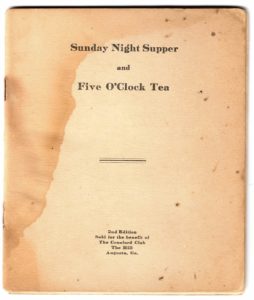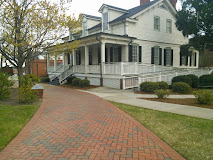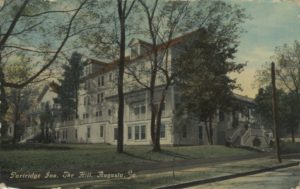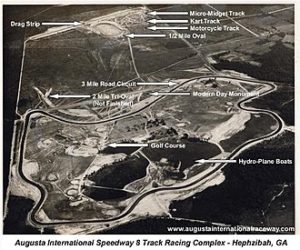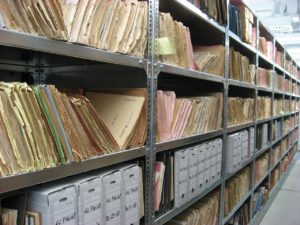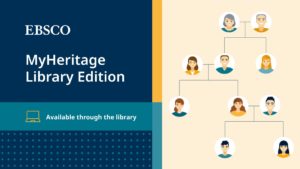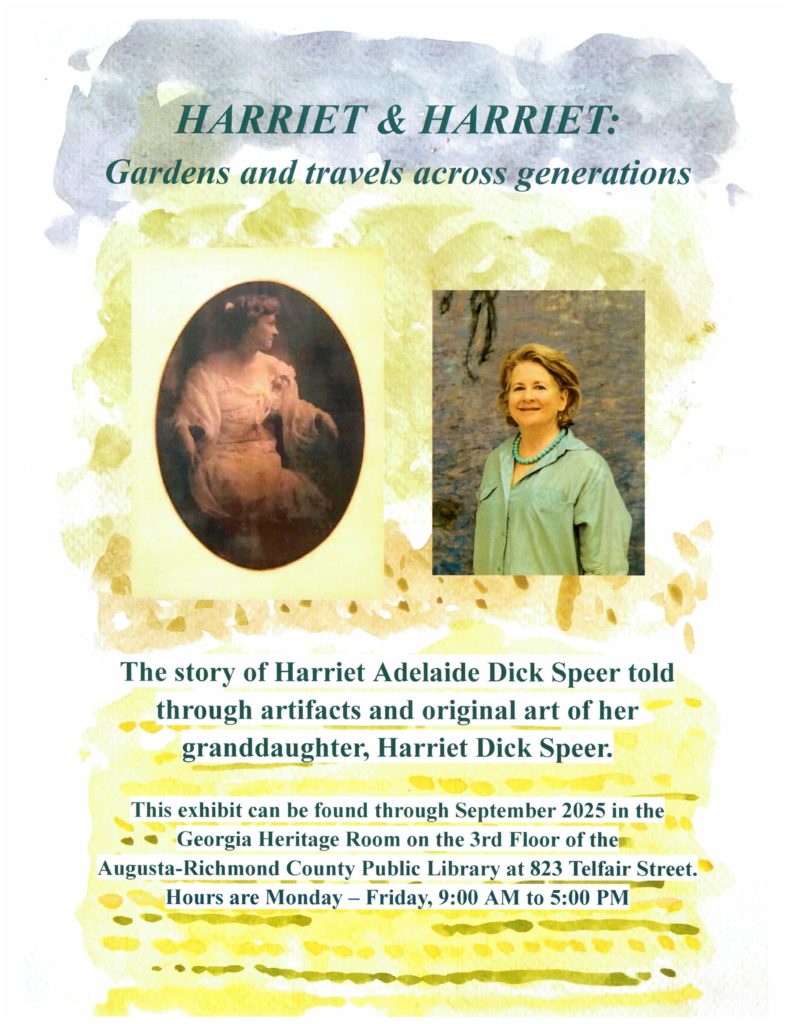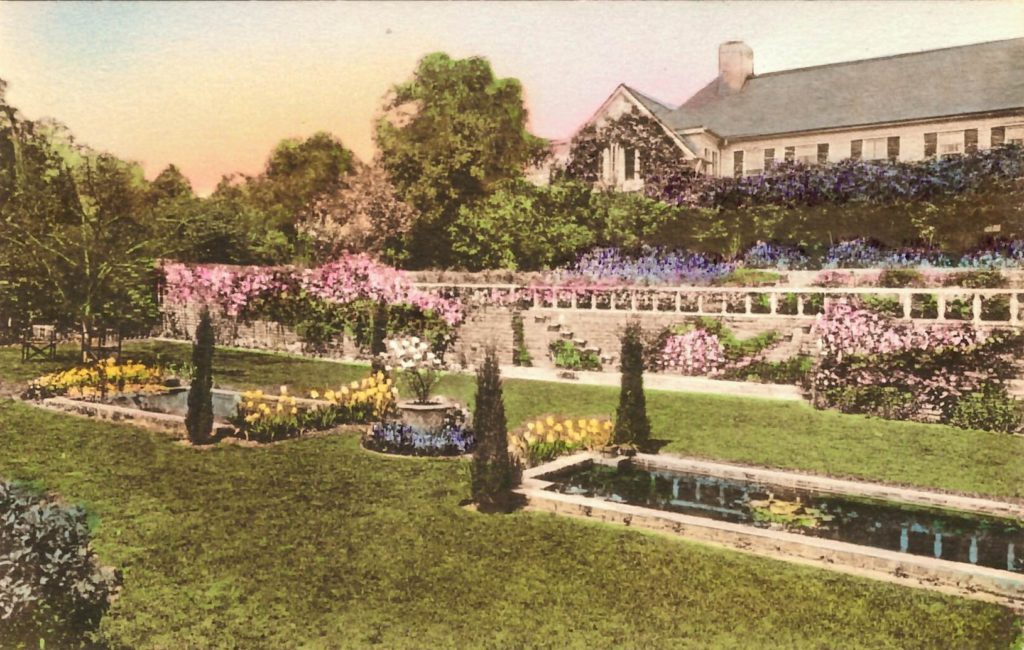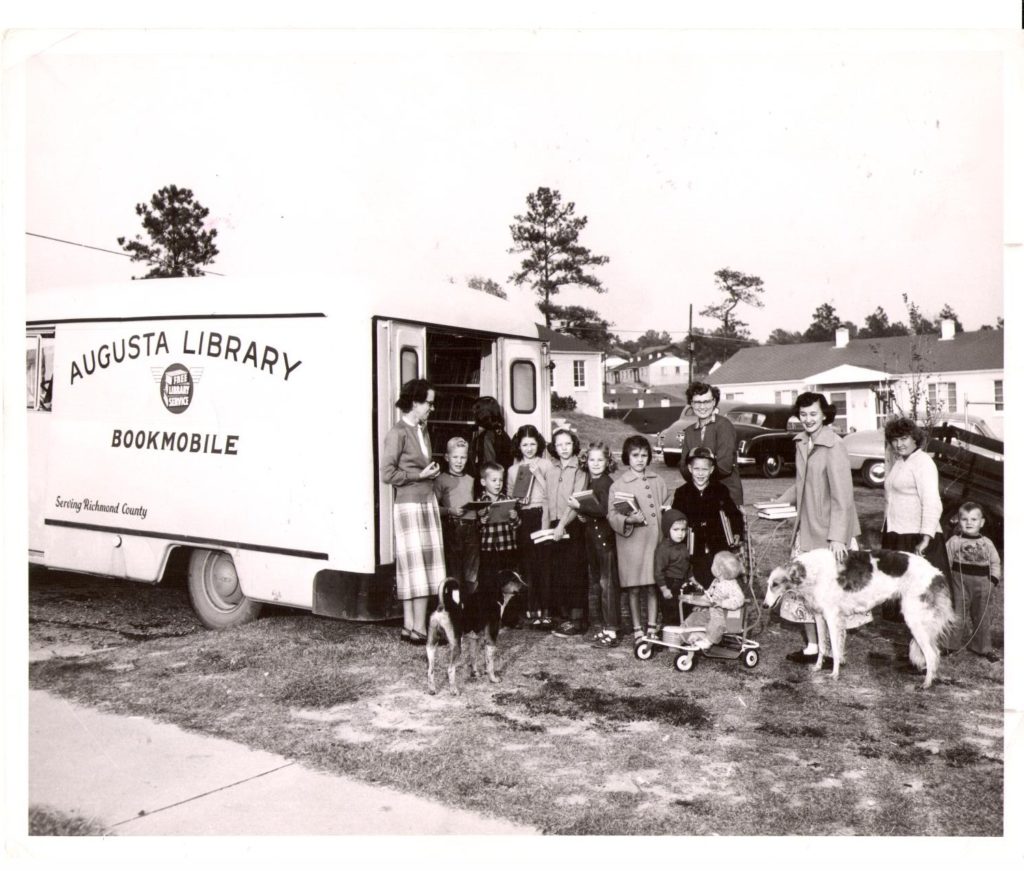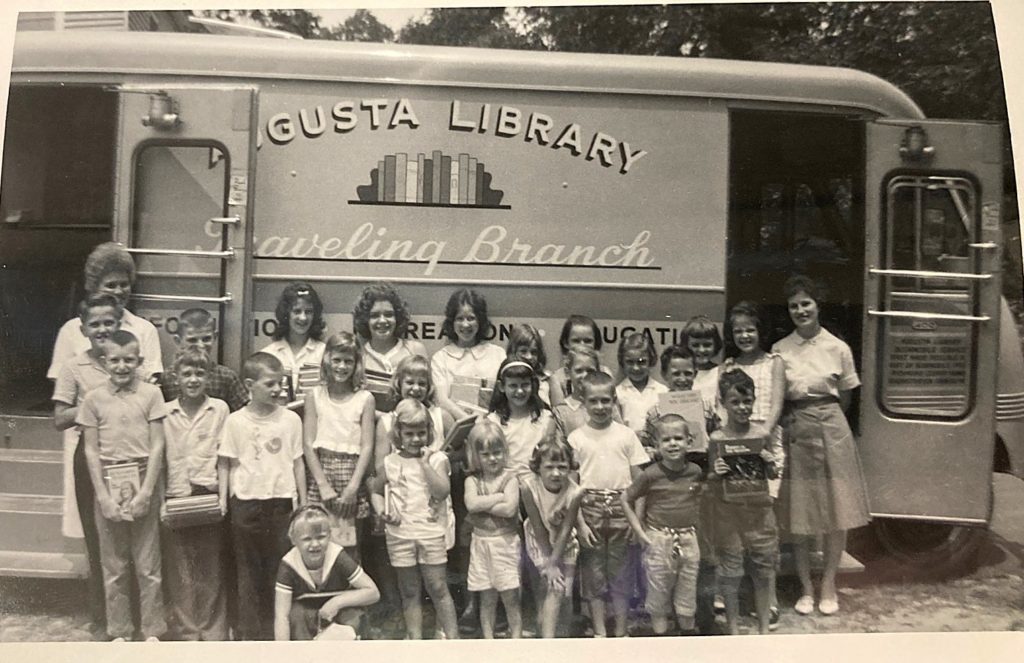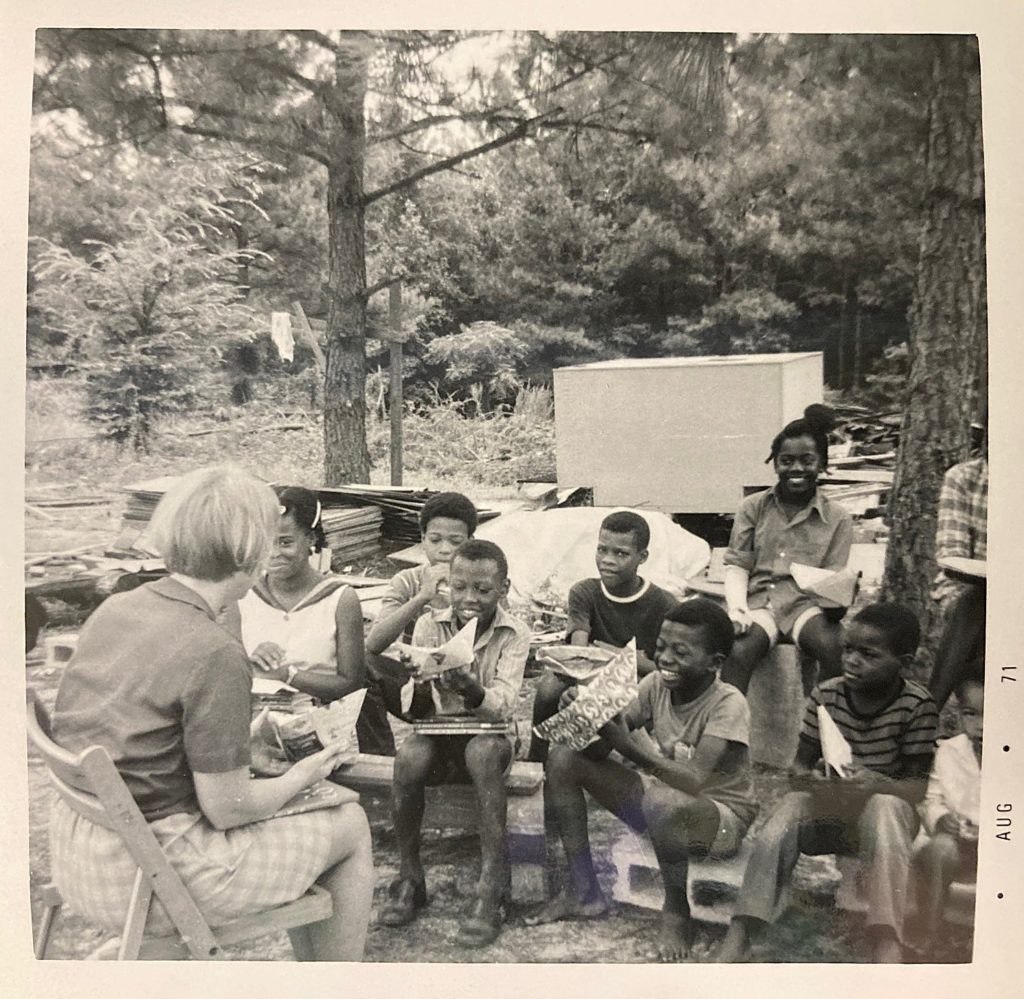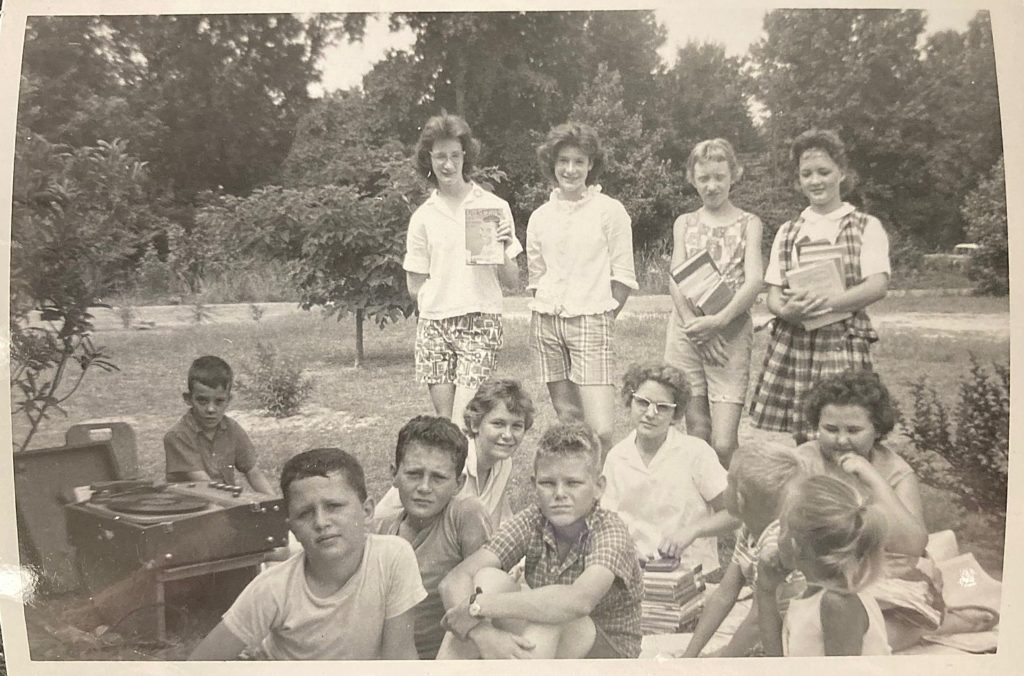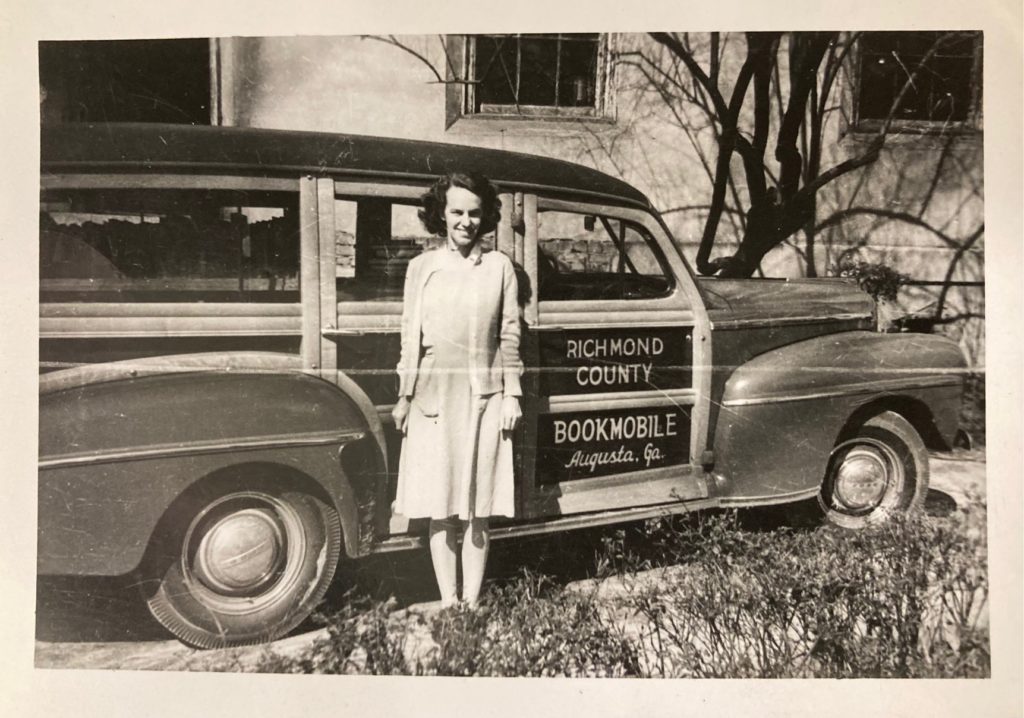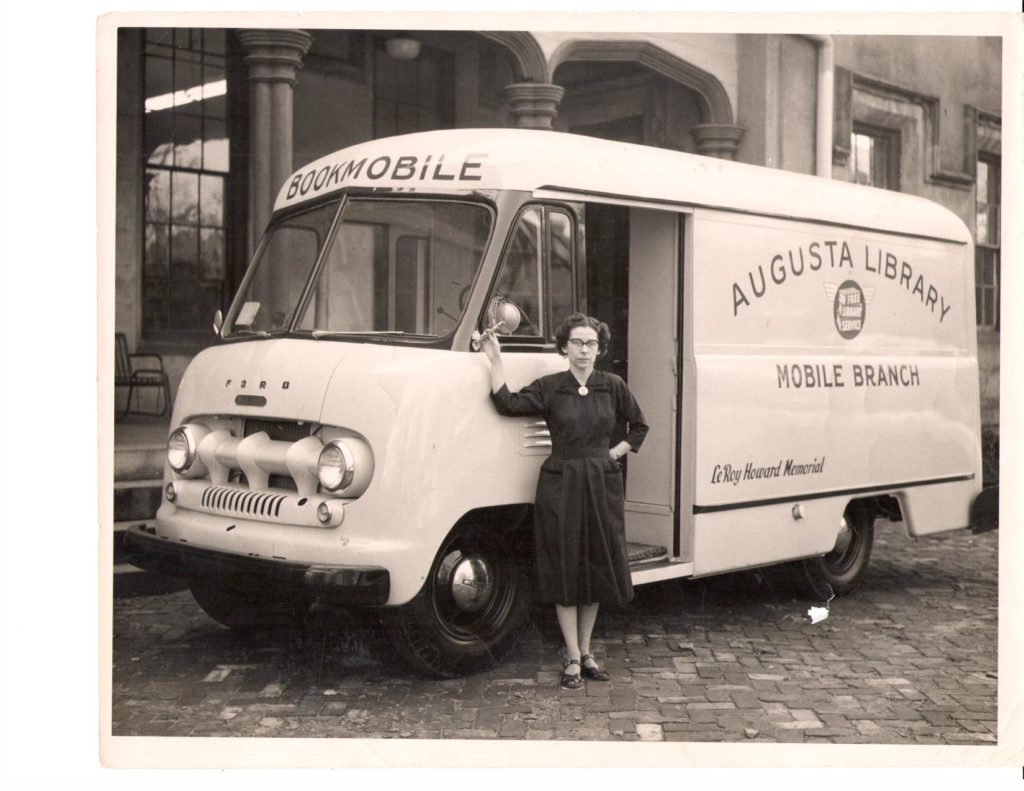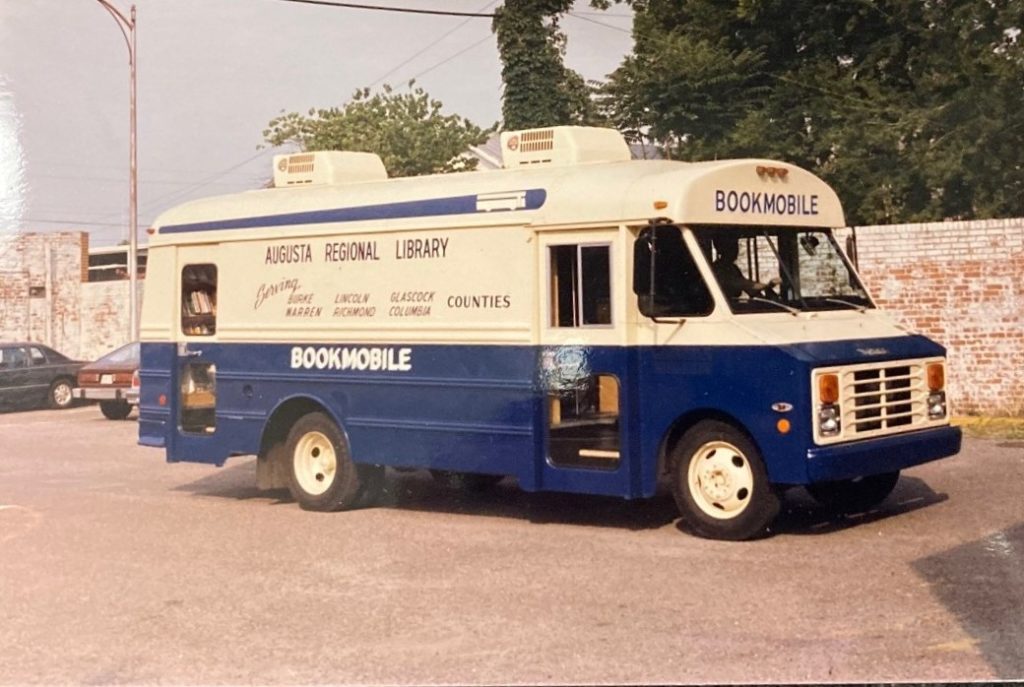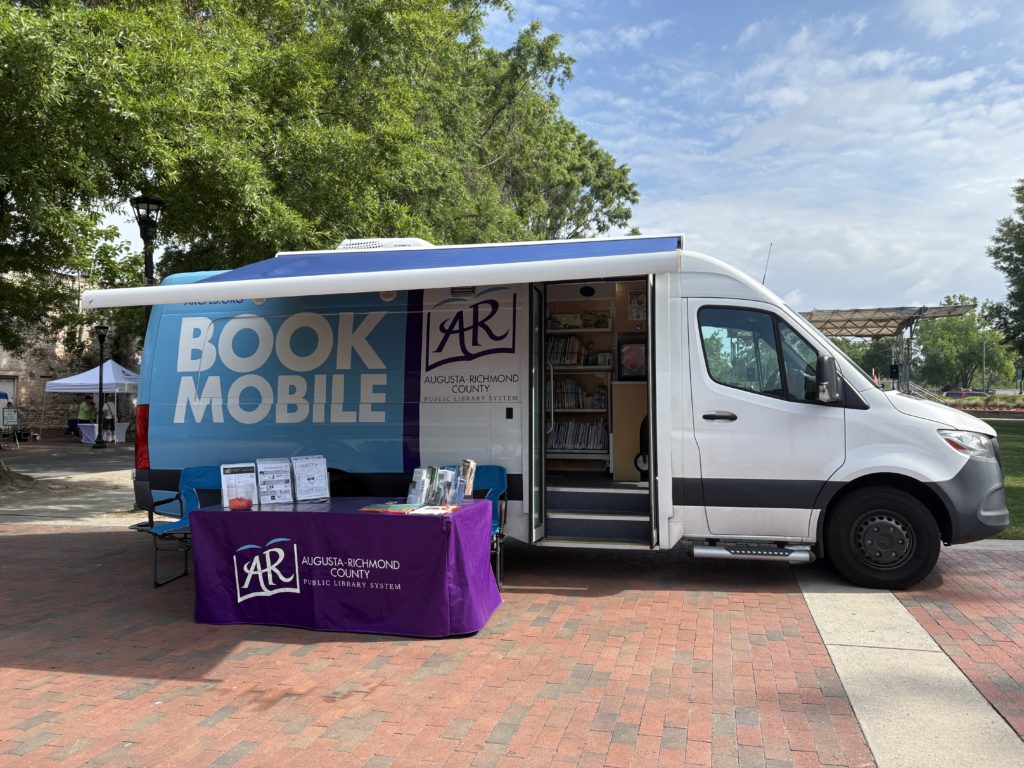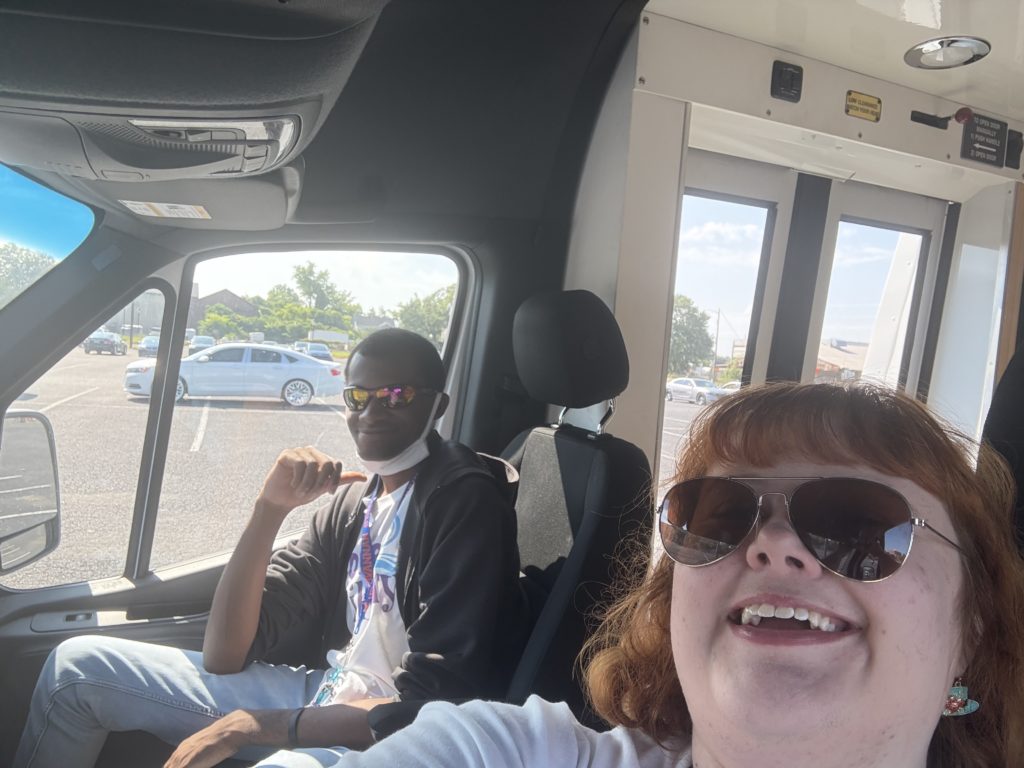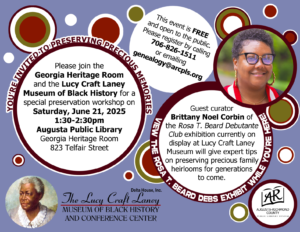The Georgia Room is lucky enough to have a copy of Augusta, one of the American Guide Series, a project implemented by The Federal Writers’ Project, part of the Works Progress Administration, which was formed during the Depression, with the intention of providing work to writers and artists. The American Guide Series of which the Augusta volume is a part intended to “preserve records, impressions and, stories, both of the past and of the present, and to bring to residents and visitors a complete picture of the country in all its aspects.”
The Federal Writers Program set up shop in Augusta on November 16, 1935. Spending a year sifting through books and archives and interviewing hundred of people, the book was finally released in 1938 under the sponsorship of City Council of Augusta. The book was very successful in portraying Augusta present and past. It even put in a series of walking tours so that users could find points of interest throughout the city.
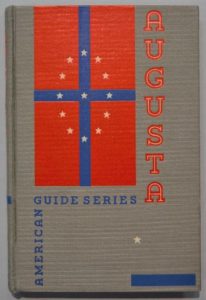
This image is used courtesy of the Augusta Museum of History
The last section of the book “Tales of Augusta” contains stories of people and landmarks unique to Augusta. Amid stories of the Haunted Pillar, Big Steve, and Richard Henry Wilde was a brief sketch entitled “An Aide to Santa Claus”. The piece mentioned a sixty-year history of the Zinn Toy Shop but, focused more on the shop’s destruction in the flood of 1908 and the subsequent efforts of the community to rebuild the little shop.
For some reason, the curiosity of this writer was piqued. Could more be said about the women at the heart of the story? While it was not as rare as we like to believe for women to work outside the home in this period, it was still unusual for a woman to be openly acknowledged as a proprietor of a business. What more could be found out about Mrs. Zinn and Miss Sarah Zinn?
Mrs. Rosella Zinn nee Leon was the originator of the Zinn Toy Shop. On April 30, 1839 she married John W.H. Zinn. The marriage appears to have been very prosperous. John W. Zinn, listed as a baker in the 1850 census, claimed real estate at a value of $3,500 and according to the 1850 slave schedule was the owner of 6 enslaved persons. For whatever reason, in 1857 Rosella Zinn, with two other ladies, was almost granted an act of relief [a divorce] from her husband. It passed through the legislature only to be thwarted by Governor Joseph E. Brown as he refused to sign it. Public opinion in Augusta was in Rosella’s favor. The Augusta Chronicle, castigated the governor’s shortcomings, used the failed bill as an example of his incompetence. “… that hybrid between a preacher and party tool can justify Gov. Brown for vetoing the bill allowing Mrs. Zinn the small pittance which she could make free from the debts of her drunken and runaway husband.” Apparently, John Zinn remained away for the rest of Rosella’s lifetime.
Rosella managed to retain some assets from the failed marriage. In the 1860 census, she claimed real estate totaling $5000 and a personal estate of $1300. According to the slave schedule, she owned 1 enslaved person, age 35.
The couple had 5 children, Sarah (1841), Henry (1844), Mary E.(1847), Georgianna, who died when she was 3 (1859), and Julia B. (1850).
It is not possible to estimate the financial effects of the Civil War on the Zinn family, but they had their share of personal suffering. The Roster of Confederate Soldiers states that Henry L. Zinn enlisted as a private on March 2. 1862, was wounded at Gettysburg on July 2, 1863 and died from wounds 1864. Hopefully Henry died surrounded by his loved ones given the length of time between his wounds and his death.
Regardless of her personal suffering, Rosella Zinn focused on building a business to provide a living for herself and her family. The 1870 census shows Mrs. Zinn with $6000 in real estate and $500 in her personal estate. By 1872 she was listed in the city directory with her profession being noted as toys and confectionary with the business entered under Confectioners and Fruit.
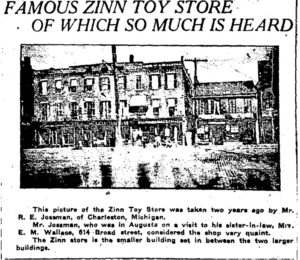
Augusta Chronicle 9/27/1908
It was around this time that the Zinns became noted for their sugar animals. An Augusta Chronicle account recalled the sugar toys from the early days of the shop, “the candy toys Mrs. Zinn made – candy men and women and dogs and horses and chickens. When one got tired of playing with them, one could eat them.” Later it was suggested that a stipulation be put on the rebuilding of the toy shop after the 1908 flood. An account given on September 14, 1908 stated, “It is a condition that Miss Sarah gets those moulds what turns out sugar candy men and soldiers and animals and horses and cows and make ‘em all, and sell ‘em for a penny too.”
But what exactly did Rosella Zinn do to make her shop into “Santa’s Depot”. For Christmas the shop became full of everything on a child’s wish list. In 1872 her wares included “ Tin, China and Mechanical Toys, Pianos, Magic Lanterns, Drums, Wagons Carriages, Chairs, Dressed Wax Dolls, India Rubber dolls, Games, Tables, Stoves, Work Boxes, Table Croquet, Christmas Tree Ornaments, Candies and a large lot of Fireworks which she will sell very reasonable.” Rosella traveled North to bring her holiday loot down to Augusta. But she didn’t rely on Christmas alone to bring shoppers to the store. She would carry items necessary for making costumes for the annual masquerade ball. Spring brought a good supply of baseballs. July brought Magic Mockingbirds and a lot of wheelbarrows in all different sizes.

1908 baseball retrieved from the Digital Public Library of America <https://gusn.us/176737>
But Christmas was her specialty, though later ads such as this one from 1876 were less loaded with detail. “Mrs. Zinn has returned from the principle depots of Santa Claus in all the large cities and Centennial Exhibition for the benefit of her little friends and children. 139 Broad Street is filled to overflow with gifts and Santa Claus goods. Everybody is welcomed and invited to call.”
Rosella could be relied on to contribute to many charitable causes and to donate prizes for charity functions. But her business and civic spirit was stilled on August 11, 1881. Her mortuary notice published in January 8, 1882, was replete with praise for a life well lived. Having all the worthy virtues one could ascribe to a lady. It was noted that her perseverance enabled her to leave an inheritance to her daughters. Most important to ‘A Friend’ was not Mrs. Zinn’s financial achievements, but “a spotless name, the “richest treasure mortal times afford”
Sarah Jane Zinn, Mary Elizabeth Gordon, and Julia Bryan Heath were the main inheritors from there mother’s estate. A sign that Sarah had participated in the running of the toy store and functioned as her mother’s right hand was the bequest of $2000 to belong to her absolutely and to be given to her before the division between the three sisters. To keep the daughters’ inheritance “free from husbands and fathers”, the lawyer H. Clay Foster was named executor of the will. It seems that the bulk of the estate was held in a trust, however a note found in Minutes U 1891-1892 Richmond County states that H. Clay Foster qualified but did not execute Rosella’s will. Affairs remained in this shape until H. Clay Foster died on August 27, 1890. The estate continued to be plagued by shoddy administration. A second executor, Marcellus P. Foster, brother of H. Clay, was named the will’s executor in 1892. At the time of his death on June 18, 1897, “M.P. Foster had in his hands certain land and property claimed to be the estate of {Rizella] C. Zinn unadministered.” Foster’s wife Pauline was granted executorship of Rosella Zinn’s will in October 1897. Her efforts to settle the estate would continue until 1904 when the property contained in the estate was sold before the court house door on the first Tuesday in June 1904 “the following described property for partition and distribution”. Finally finished, Pauline applied for letters of dismission which was duly published in the newspaper on November 14, 1904.
The Georgia Tax Digests show what all the wrangling did to Sarah’s inheritance. In the 1891 volume, Sarah’s taxable assets are listed as $600 in property 500 in merch. of every kind. The Zinn estate is valued at $6000 in property $500 in stocks and bonds. Thereafter the estate dwindles away. By 1906, Sarah is possessed of $50 merch. of any kind. The toy store hung on, but just barely.
The 1908 flood, one of Augusta’s worst, destroyed the toy shop and most of its contents. This should have been the end of Zinn’s Toy Shop.
But fate hadn’t reckoned with the city of Augusta, Georgia. For all that had been lost, nostalgia demanded the toy shop be rebuilt. A committee of determined ladies, headed by Caroline Black, Mary Lois Sibley Eve, Allie Eve Cabaniss, Elizabeth Rountree, and Ellen Hickman masterminded a fundraiser wherein donations could not total more than 25 cents. The quarters poured in from Augusta. The drive drew contributions from farther away, from small towns in Georgia and South Carolina to former customers from Arkansas and Texas and four anonymous donors from New York City who recalled “the dear lady from whom we all bought toys and lollypops.”

from The Augusta Chronicle 11/10/1883
What more can be known about this “dear lady” beyond her name, birth and death dates and legal troubles. According to newspaper articles, Miss Zinn, in spite of her condition in life, had a passion for philanthropy and took an interest the in education of poor boys “using every penny she could spare”. She had the guardianship of her nephew Arthur Gordon, who continued to work in the shop with her. She appears to have taught school for two or three years and had a reputation as a patient teacher. One writer remembers Miss Zinn with “her black curls down her face’. The same writer had more intense memories about Sarah’s wares; “her ‘lasses candy, her ginger cake doll babies and horses, and oh, every so many good things for the little ones to eat as well as toys to play with.”
Sarah used her skills at stamping and pinking to generate extra income. Stamping involves pressing a heated tool or dye onto a dampened fabric to create an indented design or pattern, similar to how leather is stamped. Pinking creates small, decorative holes or perforations in the fabric, often using a tool similar to an awl. These skills were advertised along with her toys. She also had a reputation as a “toy doctor” repairing broken toys.

This doll is an example of the toys one might find in the Zinn Toy Shop retrieved from the Digital Public Library of America <https://gusn.us/103677>
In spite of the generosity of Augusta, which had bristled at criticisms of favoritism, and the esteem in which Sarah Zinn was held by the town, plans for a new Zinn Toy Shop ran up against one unsurmountable obstacle. Sarah J. Zinn died on October 22, 1908. The paper diagnosed her. “Miss Zinn received internal injuries which together with shock caused by the flood and grief of having to give up her dear little home, no doubt hastened her death.”
What to do now with the generous fund which had topped $400. The committee reported that some funds had gone to nursing Miss Zinn in the hospital, the rest would be applied to her funeral, a decent burial and a modest marker for her resting place. It was reported that the funeral, held at the First Baptist Church, attended by Sarah’s sister Mrs. Julia Heath of Birmingham, and a niece and a cousin, both of Augusta, and Arthur Gordon, was filled to capacity. The choir had rendered Sarah’s favorite hymn “Safe in the Arms of Jesus”. She is buried in Magnolia Cemetery and the location of her grave can be provided by Augusta’s Graveside Project
And what of the little toy store? It was sold of course. What little stock was left fetched $106.83 “and the proceeds will be held intact to take care of Arthur Gordon,”
Perhaps a sad tale. By 1938 Miss Sarah was rated a legend of Augusta, rediscovered each time someone picked the up Augusta, The American Guide Series. Through this, Sarah J. Zinn, toy shop proprietor lives in memory for over one-hundred years.
This blog post attempted to relay, not just Sarah Zinn’s story, but to show the importance of the items we preserve in the Georgia room and the stories they can tell even now in our electronic 21st century. Even if it takes a curious writer to bring them to life.



